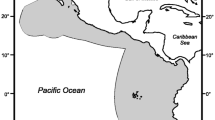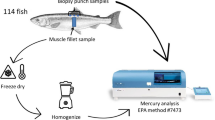Abstract
A single muscle plug was collected from each of 25 live razorback suckers inhabiting the Colorado River basin and analyzed for selenium by instrumental neutron activation. Eight fish from Ashley Creek and three from Razorback Bar exhibited selenium concentrations exceeding 8 μg/g, a level associated with reproductive failure in fish. Concentrations of selenium in eggs and milt were significantly correlated with selenium concentrations in muscle plugs and together indicate a possible explanation for the decline of this species in the Colorado River basin. Muscle plugs (<50mg) and muscle tissue (20 g) were collected from dorsal, anterior, and posterior areas of common carp, flannelmouth sucker, and an archived razorback sucker and analyzed for selenium. Concentrations of selenium in muscle plugs were significantly correlated with selenium concentrations in muscle tissue from the same location and fish (r=0.97). Coefficients of variation for selenium concentrations in each fish were <6.5% for muscle tissue, but ranged from 1.5 to 32.4% for muscle plugs. Increased variation in muscle plugs was attributed to lower selenium concentrations found in the anterior muscle plugs of flannelmouth suckers. Mean selenium concentrations in muscle plugs and tissue from dorsal and posterior areas and muscle tissue from the anterior area were not significantly different. The non-lethal collection of a muscle plug from dorsal and posterior areas of the razorback sucker and other fish species may provide an accurate assessment of selenium concentrations that exist in adjacent muscle tissue.
Similar content being viewed by others
References
Clinton OE (1977) Determination of selenium in blood and plant material by hydride generation and atomic absorption spectroscopy. Analyst 102:187–192
Hamilton SJ, Waddell B (1994) Selenium in eggs and milt of razorback sucker (Xyrauchen texanus) in the Middle Green River. Arch Environ Contam Toxicol 27:195–201
Lemly DA, Smith GJ (1987) Aquatic cycling of selenium: Implications for fish and wildlife. U.S. Dept of Interior, Fish and Wildlife Service, Fish and Wildlife Leaflet 12, Washington DC
McKown DM, Morris JS (1978) Rapid measurement of selenium in biological samples using instrumental neutron activation analysis. J Radioanal Chem 43:411–420
Minckley WL (1983) Status of the razorback sucker (Xyrauchen texanus Abbott) in the lower Colorado River basin. Southwestern Naturalist 28:165–187
Peltz LA, Waddell B (1991) Physical, chemical, and biological data for detailed study of irrigation drainage in the middle Green River basin, Utah, 1980–89, with selected data for 1982–1987. U.S. Geological Survey, Open File Report 91-530, Salt Lake City, UT
Snedecor GW, Cochran WG (1972) Statistical Methods, Sixth Edition. Iowa State University Press, Ames, IA. Sixth Edition. pp 272–275
Tyus HM (1987) Distribution, reproduction, and habitat use of the razorback sucker in the Green River, Utah, 1979–1986. Trans Amer Fisheries Society 116:111–116
Tyus HM, Karp CA (1990) Spawning and movements of razorback sucker (Xyrauchen texanus) in the Green River basin of Colorado and Utah. Southwestern Naturalist 35:427–433
Williamson, JH (1992) Colorado Squawfish Genetic Survey — Tissue sampling protocol 1992. U.S. Fish and Wildlife Service, Fisheries and Federal Aid, Denver Federal Center, Denver, CO, 12 pp
Author information
Authors and Affiliations
Rights and permissions
About this article
Cite this article
Waddell, B., May, T. Selenium concentrations in the razorback sucker (Xyrauchen texanus): Substitution of non-lethal muscle plugs for muscle tissue in contaminant assessment. Arch. Environ. Contam. Toxicol. 28, 321–326 (1995). https://doi.org/10.1007/BF00213109
Received:
Revised:
Issue Date:
DOI: https://doi.org/10.1007/BF00213109




